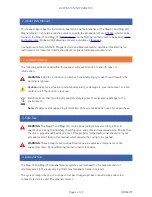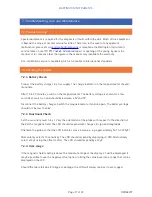
BARTINGTON INSTRUMENTS
Page 14 of 20 OM0382/9
Note:
When clamping these probes in fixed installations, the clamp pressure should not
be applied in the region of the sensing element. These probes are engraved with an arrow
indicating the sensing direction and a spot indicating the centre of the sensitive region.
The sensing axis of the B and D probes is in line with the axis of the cylindrical enclosure. The
sensing axis of the C and E probes is along the axis of the short cylinder at the end of the probe.
The magnetic detection axis and centre of sensitive volume are marked on each probe.
5.3.2. High Field Probes (Types D, E, G)
Note:
When using the high field probes, the displayed values and offset (Mag-01H) should
be multiplied by 10 to obtain the true reading. For these probes the maximum analogue
output range is
±
4.5V, with the maximum range of the LCD limited to 2mT.
5.3.3. Cryogenic Probes (Types F, G)
Note:
The cryogenic probes are suitable for operation at temperatures down to that of
liquid helium and have 1m of 4 x 0.2mm enamelled copper wires connected to the element,
for use in a cryostat. This length can be extended to a maximum of 5m if required.
Note:
The cryogenic probe can be mounted by bonding, using a minimal mount epoxy
adhesive, or by loosely supporting the probe within a tube.
Note:
The potted section on the solder terminal contains variable resistors that may
be affected by low temperatures. It is therefore recommended these are kept at room
temperature, outside any cryogenic chamber.
Note:
The four enamel-coated 1m x 0.2mm diameter copper connecting wires should
be subjected to the minimum amount of flexure to avoid fractures. The probes are
unprotected and should be handled with great care.
Note:
When mounting the cryogenic probe, the copper sensor wires should be either fed
through an access hole in the chamber or disconnected from the electronics and soldered
directly onto a feedthrough connector. The outside of the feedthrough should then be
connected to the board.
Note:
For wiring information, please refer to drawings
DR2908 (Mag F Probe)
and
DR2909
(Mag G Probe)
on the product page of the Bartington Instruments website.
5.3.4. Proximity Effects
Note:
Mag cryogenic probes can only operate in close proximity to each other if they are
mutally orthogonal. Otherwise, to avoid interaction, no two Mag cryogenic probes should
be operated within 10mm of each other.






































